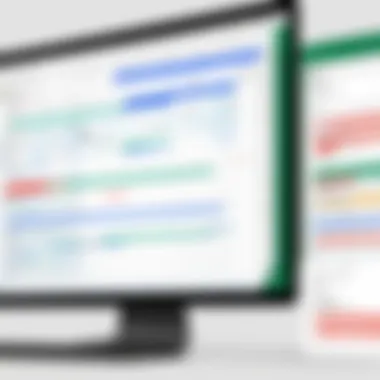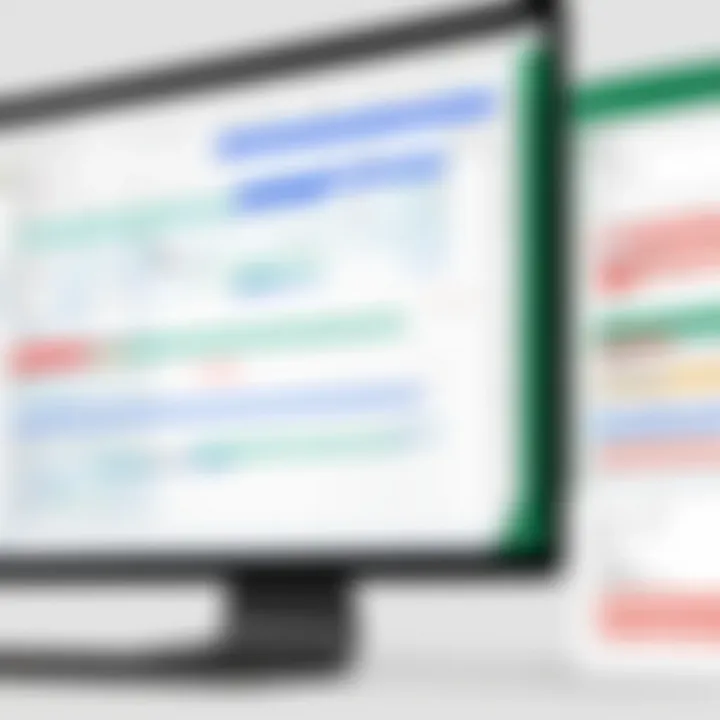Mastering Task Management with Google Sheets


Intro
Task management is crucial for any organization. Efficiently managing tasks can greatly improve productivity. Google Sheets stands out as a versatile tool in this area. It is affordable, accessible, and offers a range of functions that can be customized to meet specific needs. This article explores how to optimize task management using Google Sheets, focusing on its functionalities and practical applications.
Software Category Overview
Purpose and Importance
Google Sheets is more than just a spreadsheet tool. It serves as a platform for collaborative work, especially when it comes to task management. Users can create and share task lists, assign responsibilities, and track progress in real time. The importance lies in its ability to centralize information and make it accessible to all team members. When everyone is aligned on tasks, it leads to better accountability and transparency.
Current Trends in the Software Category
Recent trends indicate that many businesses are moving towards cloud-based solutions for task management. Google Sheets fits this trend well. Its integration with Google Workspace allows for seamless collaboration. Many teams are now adopting automation features to streamline processes. The increasing use of templates and add-ons shows how users are customizing their experiences to better manage workloads efficiently.
Data-Driven Analysis
Metrics and Criteria for Evaluation
To evaluate the effectiveness of Google Sheets for task management, it is necessary to consider a few key metrics. These include:
- User Adoption Rate: How many team members actively use Sheets?
- Task Completion Rates: Are tasks being completed on time?
- Error Rates: Are there frequent mistakes in task assignments or tracking?
Assessing these metrics can provide insights into how Google Sheets is enhancing task management within teams.
Comparative Data on Leading Software Solutions
Google Sheets competes with various task management tools, each offering unique features. Notable alternatives include Asana, Trello, and Microsoft Excel. While each of these tools has specific strengths, Google Sheets offers flexibility and customizability that many find appealing. This justifies its use in various contexts from small teams to large organizations.
"Google Sheets allows a level of customization that is often difficult to achieve with other task management tools."
In summary, the integration and real-time collaborative capabilities of Google Sheets make it a strong contender for task management solutions. Its balance of simplicity and depth caters to a wide range of users, from casual planners to project managers.
Intro to Google Sheets for Task Management
Task management plays a crucial role in enhancing productivity in both personal and professional environments. As the demands on our time increase, so does the need for effective organization and tracking of tasks. Google Sheets emerges as a versatile tool that can streamline this process. This section introduces how Google Sheets can optimize task management, emphasizing its user-friendly interface and collaborative features.
Overview of Google Sheets
Google Sheets is a cloud-based spreadsheet application that allows users to create, edit, and share spreadsheets online. It is part of the Google Workspace suite, making it easily accessible through any device with internet connectivity. Its intuitive design features essential functionalities such as formulas, data analysis tools, and real-time collaboration. These attributes make Google Sheets not only powerful for data management but also a favored choice for task management.
Advantages of using Google Sheets include:
- Accessibility: Users can access their spreadsheets from anywhere, at any time. This accessibility is essential for teams working remotely.
- Real-Time Collaboration: Multiple users can simultaneously work on the same sheet. Changes are updated in real-time, promoting seamless collaboration.
- Integration Options: Google Sheets integrates with other tools like Google Calendar and Google Tasks, enhancing its functionality in managing tasks.
- Customizability: Users can personalize their spreadsheets to fit their specific needs, ensuring a tailored approach to task management.
Importance of Task Management
Effective task management is not merely a time-saving mechanism; it is vital for maximizing efficiency and accountability. Poor task management can lead to delays, misunderstandings, and ultimately, project failure. In contrast, superior task management fosters clarity of purpose, helping individuals and teams stay focused on their goals.
By implementing a structured task management system through Google Sheets, users can benefit from:
- Enhanced Organization: Tasks can be categorized, prioritized, and tracked, making it easier to visualize progress.
- Improved Accountability: Assigning tasks and deadlines promotes responsibility among team members, leading to better project outcomes.
- Data-Driven Insights: The ability to analyze completed tasks and ongoing projects helps in assessing performance and improving future planning.
"Effective task management is the bedrock of successful projects. Google Sheets provides the tools necessary for this success."
In summary, the integration of Google Sheets into task management processes not only promotes individual productivity but also enhances team collaboration, ultimately leading to a more organized and efficient workflow.
Setting Up Your Google Sheets Task Manager
Setting up your task manager in Google Sheets is a critical step for achieving enhanced productivity and organization. The initial structure and layout of your task management system lay the foundation for consistent workflow and tracking responsibilities. When executed effectively, this setup facilitates easy monitoring of tasks, prioritization, and accountability among team members. It is key to develop an intuitive and user-friendly interface in your spreadsheet. This will significantly improve usability and ensure that all users are able to interact with the system without confusion.
Creating a New Spreadsheet
Creating a new spreadsheet is the first practical step in setting up your task manager. This process starts with accessing Google Sheets. Visit the Google Sheets website or open the app if you have it installed. You will see an option to start a new spreadsheet. Click on the blank option to open a new sheet.
Within this new spreadsheet, consider naming your document appropriately. A clear title not only enhances organization but also helps collaborators understand its purpose at a glance. For example, naming it "Project Task Tracker" can immediately convey its function.
Once created, familiarize yourself with the interface. It consists of rows and columns that can be adjusted to suit your layout preferences. Here are some steps for setting up:
- Adjust Column Widths: Make each column wide enough to handle the data you intend to input.
- Freeze Header Rows: This helps to maintain visibility of your headers while scrolling through long lists of tasks.
- Select a Grid Line Style: Customizing grid lines can make your task manager visually appealing and easy to navigate.
Designing Your Layout
The design of your task manager's layout influences how effectively you and your team can manage tasks. A well-planned layout ideally includes several key components. These components generally consist of columns that define task details. Think about including the following columns in your sheet:
- Task Description: A clear description of what the task entails.
- Due Date: Including a due date helps everyone understand timelines and priorities.
- Assigned To: This column designates who is responsible for the task.
- Status: Whether the task is pending, in progress, or completed.
- Priority Level: Allowing you to quickly gauge the significance of each task.
After you define your columns, consider color-coding specific elements in your spreadsheet. Color coding can visually enhance your task manager, making it easier to identify high-priority tasks or track progress.
Finally, ensure that your layout allows for growth. As projects develop or teams expand, having a flexible layout will accommodate new tasks or additional users without the need for a complete redesign.
Key Features for Task Management
Effective task management relies heavily on the usability of the tools employed. Google Sheets offers several key features that enhance its effectiveness. By understanding and utilizing these features, users can create a more organized, efficient, and collaborative environment. These features not only facilitate better tracking and accountability but also help reduce time spent on task-related activities.
Data Organization with Columns
Data organization plays a critical role in task management. In Google Sheets, columns allow users to categorize tasks effectively. For instance, standard columns might include ‘Task Name’, ‘Due Date’, ‘Priority’, and ‘Status’. Organizing them in a systematic way can drastically improve clarity.


Each column serves a distinct purpose. The ‘Task Name’ column outlines what needs to be done, while the ‘Due Date’ column ensures timelines are respected. The ‘Priority’ column lets users know which tasks should be tackled first based on urgency. Finally, the ‘Status’ column highlights whether a task is pending, in progress, or completed, providing an instant overview of task progression.
"Clear organization of data leads to better decision-making and prioritization."
Utilizing Checkboxes
Checkboxes in Google Sheets offer a simple yet powerful feature for tracking task completion. Adding checkboxes next to each task allows users to mark them as done visually. This not only affirms a sense of accomplishment but helps in planning future tasks effectively.
Using checkboxes simplifies workflow management, as users can quickly glance at the sheet to determine what is remaining. This feature allows for flexibility in completing tasks, as they can be marked off at the user’s own pace, making it suitable for both individual and team use.
Color Coding for Prioritization
Color coding is another effective feature in Google Sheets for enhancing task management. By applying specific colors to different tasks, users can easily communicate priority levels and deadlines. For example, red can signify urgent tasks while yellow can denote less critical ones.
This visual aspect makes it simpler for users to prioritize their workloads. Furthermore, it helps teams coordinate on tasks without needing detailed explanations. By simply looking at the colors, team members can quickly understand what needs their attention.
Collaboration and Sharing
Collaboration and sharing features in Google Sheets are crucial for effective task management within teams. These functionalities not only promote real-time interaction but also enhance transparency, accountability, and productivity among team members. Successful project execution, especially in a fast-paced work environment, often relies on the ability to work cohesively. By capitalizing on the capabilities of Google Sheets, teams can ensure they remain aligned and informed, which can lead to improved outcomes.
Inviting Collaborators
Inviting collaborators in Google Sheets is a straightforward process. First, you need to click the blue "Share" button located at the top right of your spreadsheet. You can input the email addresses of team members or create a shareable link. Be sure to set the permissions accordingly, opting for either view, comment, or edit access based on the level of involvement you expect from each collaborator.
Considerations during this step are significant. Clearly define what the role of each collaborator will be. If someone is to provide feedback only, limit their permissions to commenting. Alternatively, if a team member is responsible for updating the task list, grant them editing rights. This practice mitigates the risk of unauthorized changes and helps maintain the integrity of your task management system.
Commenting and Feedback
One of the standout features of Google Sheets is its commenting functionality. Team members can leave comments directly on specific cells or rows, which allows for targeted feedback. To comment, right-click on a cell and select "Comment," or use the shortcut Ctrl + Alt + M. This feature promotes clarity and facilitates focused discussions about particular tasks, ensuring that everyone is on the same page.
Comments can be resolved, allowing users to track which suggestions and queries have been addressed. This process creates an organized feedback loop, simplifying task revisions and ensuring accountability.
Additionally, encouraging team members to actively use the commenting feature fosters a culture of communication. By regularly checking and responding to comments, you can keep the workflow smooth and improve overall task execution. Always remember to periodically review comment threads, as this can provide insights into the challenges your team might be facing and allow for timely interventions.
Real-time collaboration ensures that all team members can contribute their insights, making the task management process more collaborative and comprehensive.
Automation in Google Sheets
Automation serves as a cornerstone for efficient task management in Google Sheets. It allows users to streamline repetitive tasks and minimize potential human errors, thereby augmenting productivity. The automation features in Google Sheets not only save time but also facilitate consistent updates and effective coordination within teams. For professionals and project managers, understanding how to leverage automation tools provides a critical advantage in today’s fast-paced work environment.
Efficient task management demands a systematic approach, and automation addresses this by automating notifications and formatting, among other elements. These capabilities augment the functionality of Google Sheets, making it an indispensable tool for both individuals and teams aimed at improving workflow processes.
Setting Up Notifications
Notifications in Google Sheets are essential for ensuring that all team members stay informed about changes in task status or deadlines. For example, you can set up notifications to alert you when tasks are completed or when they are overdue. This feature can be configured easily by navigating to the tools menu and choosing the notification rules option. By establishing clear notification pathways, users can enhance accountability and ensure that tasks are followed up in a timely manner.
To set up notifications:
- Go to the top menu and click on Tools.
- Select Notification rules.
- Choose the specific changes you want to be notified about, such as 'Any changes are made' or 'A user submits a form'.
- Specify if you want to receive notifications immediately or as a daily digest.
These notifications play a crucial role in fostering communication, keeping team members aligned with project goals and deadlines, which ultimately leads to improved oversight and accountability.
Using Conditional Formatting
Conditional formatting in Google Sheets allows users to visually highlight important information based on specific criteria. This enhances the overall readability of task lists and fosters quick comprehension of project statuses. For example, a task can be marked in red if it is overdue or highlighted in green when completed. This instant visual feedback empowers users to prioritize tasks that require immediate attention, thus driving timely action.
To use conditional formatting effectively, follow these simple steps:
- Select the cells you wish to format.
- Click on Format from the menu.
- Choose Conditional formatting.
- Set your rules based on situations, such as if the task is overdue, format the cell with a red background.
- Apply the settings by clicking Done.
This functionality not only aids in task prioritization but also eliminates the need to constantly review lists manually. Conditional formatting ensures that users can focus on the most critical tasks, maximizing efficiency in task management.
Remember: Clear formatting can prevent task overload and help teams maintain focus on what truly matters.
Integrating with Other Tools
Integrating Google Sheets with other tools enhances its functionality, transforming a simple spreadsheet into a versatile task management system. This integration is essential for users looking to streamline their workflow and improve productivity. By connecting to various applications, you can ensure that your data is up to date, minimize manual input, and maximize the utility of your task manager. There are several popular tools that can work seamlessly with Google Sheets, including Google Calendar and Google Tasks. Each brings its unique benefits and considerations, making them valuable companions in your task management journey.
Linking Google Calendar
Linking Google Calendar to Google Sheets allows for an organized and efficient approach to time management. By integrating these tools, you can automatically sync events with your task list. This means that deadlines and meetings can be viewed in one central place, which can reduce the risk of double-booking or missing important tasks.
Here are some key benefits of linking these tools:
- Real-Time Updates: Any changes in your Google Sheets can be reflected in your Google Calendar almost instantly. This reduces the need for manual updating of events.
- Enhanced Visibility: With tasks aligned along the calendar, you can visualize your workload better, identifying peak times for productivity.
- Automated Reminders: Setting reminders in Google Calendar for critical tasks ensures that nothing falls through the cracks. Managing your tasks with alerts can enhance accountability.
When you integrate these tools, consider the following:
- Security Considerations: Ensure that sharing settings are properly configured to maintain privacy.
- User Training: Familiarize all team members with the integrated system to maximize its effectiveness.
Connecting with Google Tasks
Connecting Google Tasks with Google Sheets offers another layer of optimization for task management. Google Tasks is a straightforward tool for tracking small lists of tasks and to-dos, and when linked with Sheets, it provides a more powerful overview of ongoing projects.
The advantages of this integration include:
- Task Tracking: Easily manage tasks and subtasks while seeing their relationship to broader project goals.
- Automatic Synchronization: Any updates or changes made in Google Sheets can automatically update your task lists in Google Tasks, reinforcing accuracy.
- User-Friendly Interface: Google Tasks boasts a simple layout that many find more accessible than complex project management software.
When setting this up, consider the following factors:


- Task Prioritization: Decide how to categorize tasks to ensure easy tracking and discussions.
- Collaboration Features: Ensure that team members understand how to access and manage tasks seamlessly across both platforms.
By optimizing your task management through integrations, you are not only enhancing efficiency but also creating a more cohesive system that aligns tasks with time management. This holistic approach will likely lead to improved productivity and better team outcomes.
Integrating tools like Google Calendar and Google Tasks with Google Sheets can multiply your efficiency by creating an interconnected web of task management.
Using Templates for Task Management
Using templates can significantly streamline task management in Google Sheets. They provide a foundation that users can build upon, making it easier to maintain structure and consistency in task tracking. The availability of various templates allows users to select a layout that best suits their needs. This process not only saves time but also minimizes the chances of errors in setup that can arise when creating a task manager from scratch. Task management templates often come pre-populated with useful features like drop-down lists and conditional formatting, making them functional right away.
Moreover, templates can enhance collaboration within teams. When team members work from the same format, communication improves, facilitating smoother updates and changes. This shared structure ensures that all participants are on the same page regarding tasks and deadlines. By using templates, the management process can become more effective, as everyone has clear visibility of responsibilities and progress.
Exploring Available Templates
Google Sheets hosts a variety of templates for task management that cater to different needs. Some users might prefer a simple checklist-style template, while others may need a more complex project management layout.
Types of Templates
- To-Do Lists: These templates focus on tasks with checkboxes for easy tracking.
- Kanban Boards: Useful for visualizing tasks in different stages of completion, often represented in columns.
- Project Management Plans: These templates typically include sections for timelines, tasks, assignees, and status updates.
- Gantt Charts: A more detailed view that outlines project timelines alongside dependencies between tasks.
Each of these templates offers unique features and benefits that can be leveraged based on specific project requirements. Users can find these templates through the Template Gallery in Google Sheets or explore online platforms that offer free or paid templates designed for enhanced productivity.
Remember: Utilizing a well-structured template can save substantial startup time and resource allocation, ensuring that the focus remains on task execution rather than on administrative setup.
Customizing Templates to Fit Needs
While templates provide a fantastic starting point, customization is essential for aligning them with individual or team requirements. By modifying these templates, users can create a system that accurately represents their workflow and priorities.
Steps for Customization
- Identify Key Metrics: Determine what aspects are important for your task management, such as deadlines, priorities, or the workload.
- Modify Columns and Headers: Change existing column names to reflect the specific elements you want to track. For instance, if tracking project phases, rename columns to match life-cycle stages.
- Add Formulas: Incorporate formulas for automatic calculations, like summing up completed tasks or calculating hours worked.
- Customize Aesthetic Elements: Adjust colors or fonts to enhance clarity and usability, making the spreadsheet more visually intuitive.
Customizing templates aids in reinforcing accountability among team members, as everyone can easily track their responsibilities. This personalization process not only fine-tunes the relevance of the task manager but also reinforces user engagement with the tool. By adapting existing resources, task management becomes tailored and dynamic.
Tracking Progress and Accountability
Tracking progress and accountability are critical components of effective task management. In any organizational environment, whether it’s a small team or a larger enterprise, being able to monitor what has been done and what remains to be done is vital for achieving goals.
Creating Progress Charts
Utilizing progress charts is a straightforward yet powerful method to visualize task completion and workflow. Google Sheets offers several tools to create these charts, making it easy to represent data graphically.
When setting up your progress charts, take into account the following steps:
- Data Entry: First, make sure your tasks are structured properly in Google Sheets, with columns for task names, deadlines, and status.
- Select Data Range: Highlight the range of data you want to visualize. This should include the status of tasks.
- Insert Chart: Go to the "Insert" menu and select "Chart." Choose the chart type that best represents your data, like bar or line charts for progress tracking.
- Customize Chart: Tailor your chart with titles, color changes, and labels. This step is crucial for clarity so stakeholders can quickly grasp the progress.
By visualizing statistics, teams can quickly assess how much work is left and adjust their strategies if needed. Monitoring charts not only helps in visualization but also substantiates accountability among team members.
Reviewing Task Completion
Regularly reviewing task completion can enhance accountability within teams. It is important to establish a process for evaluating completed tasks.
Here are some practical methods:
- Weekly Review Meetings: Schedule meetings to discuss progress. These gatherings allow team members to present what tasks they have completed, creating a sense of responsibility.
- Status Updates in Google Sheets: Use a dedicated column to mark tasks as "completed.” This real-time updating encourages transparency.
- Deadline Reminders: Set reminders for approaching deadlines within Google Sheets. Regular prompts can serve as accountability checks for individual responsibilities.
Understanding what has been completed and what tasks still need attention keeps everyone focused on the overall objectives. As individuals take ownership of their tasks, team dynamics improve, fostering a culture of accountability.
Regular tracking and updates ensure that no task slips through the cracks, driving productivity.
In summary, tracking progress and maintaining accountability through structured methods in Google Sheets not only aids in achieving goals efficiently but also strengthens team cohesion.
Common Pitfalls to Avoid
Effective task management requires careful attention to details, especially when using tools like Google Sheets. While it is possible to design a highly functional task manager through Google Sheets, there are several common pitfalls that can hinder productivity and efficiency. Understanding these pitfalls is crucial for maximizing the benefits of your task management system. In this section, we will examine two significant errors: overcomplicating the spreadsheet and neglecting regular updates.
Overcomplicating the Spreadsheet
Overcomplication in task management spreadsheets often leads to confusion rather than clarity. A common mistake is adding too many columns or rows without a clear purpose. When users cram excessive data into a single sheet, they risk losing sight of the tasks themselves. This complexity can turn what should be a straightforward tool into a cumbersome chore.
To avoid this, focus on simplicity. Evaluate which pieces of information are critical for task tracking. Here are some tips to maintain a clear structure:
- Limit Columns: Only include necessary columns such as task name, due date, status, and assignee. Too many columns can dilute focus.
- Use Data Validation: Implement drop-down lists for status updates, ensuring that consistency is maintained across entries.
- Highlight Key Data: Use conditional formatting for high-priority tasks, making it easy to identify what's urgent at a glance.
By streamlining the design, you can ensure that the spreadsheet serves its intended purpose without overwhelming users.
"Simplicity is the ultimate sophistication."
This quote emphasizes the power of straightforwardness in effective task management.
Neglecting Regular Updates
Another frequent pitfall is the neglect of regular updates within the task management system. Task management is not a set-and-forget activity; it requires ongoing attention to reflect current statuses accurately. Failing to update the spreadsheet can result in misplaced priorities, missed deadlines, and a lack of accountability within teams.
To prevent this oversight, consider implementing the following strategies:
- Set Reminders: Utilize Google Calendar or other tools to send reminders for regular updates.
- Daily Check-Ins: Allocate a few minutes each day or week dedicated to reviewing and updating tasks. This will help keep the spreadsheet current and minimize errors.
- Assign Responsibilities: Designate team members responsible for updating specific sections of the spreadsheet. This promotes accountability and encourages engagement.
Regularly updating the task manager ensures that everyone involved stays informed and can make timely decisions based on the most current information. Avoiding this pitfall contributes significantly to improved productivity.
In summary, recognizing and addressing the common pitfalls of overcomplicating the spreadsheet and neglecting regular updates is essential for effective task management with Google Sheets. A streamlined, frequently updated system helps enhance focus and ensures accountability.


Advantages of Using Google Sheets for Task Management
Google Sheets offers several compelling advantages for task management, making it a favored tool among professionals and teams. Understanding these benefits is essential to optimizing workflows and enhancing overall productivity. With its user-friendly interface and rich feature set, Google Sheets becomes a vital instrument in effective task management.
Cost-Effectiveness
One of the most prominent advantages of Google Sheets is its cost-effectiveness. As a free tool accessible through a Google account, it eliminates the need for purchasing expensive software licenses. This aspect is particularly valuable for startups and small businesses that strive to minimize expenditures while maximizing efficiency.
Moreover, the collaborative features allow multiple users to edit the same spreadsheet simultaneously, without requiring additional user fees. This encourages teamwork and simplifies communication.
- No Licensing Fees: No hidden costs for additional features.
- Collaboration at No Extra Cost: Share and work together without adding expenses.
These aspects culminate in significant savings for organizations, allowing companies to allocate resources to other crucial areas.
Accessibility and Flexibility
Google Sheets is inherently designed for accessibility and flexibility. Being cloud-based means that users can access their spreadsheets from any device, be it a computer, tablet, or smartphone. This allows for real-time updates and modifications, ensuring that team members can stay informed about task progress whether they are in the office or on the go.
The flexibility also extends to customization of spreadsheets. Users can tailor their task management systems based on individual or organizational needs. Whether it involves formulas, conditional formatting, or unique layouts, Google Sheets allows for personal choices that can enhance task tracking.
- Cross-Device Compatibility: Access from anywhere, anytime.
- Customizable Features: Adapt the spreadsheets as needed.
This dual aspect of accessibility and flexibility enables teams to work efficiently, adapting their workflows as necessitated by changing demands.
Using Google Sheets not only democratizes access but also empowers teams to tailor their task management structures to fit specific roles and responsibilities, resulting in a more coherent and focused approach to task execution.
Case Studies of Effective Task Management
Analyzing case studies provides invaluable insights into how Google Sheets can enhance task management. These real-world examples highlight practical applications, illustrating both the challenges and successes businesses and academic groups have encountered. This section focuses on key aspects such as adaptability, team collaboration, and productivity improvements. The case studies will demonstrate how specific features of Google Sheets can be leveraged in various contexts.
Team Projects in Small Businesses
In a typical small business setting, teamwork is paramount for achieving goals efficiently. Many small businesses utilize Google Sheets to manage projects, track progress, and streamline communication among team members. One clear example is a small marketing agency that needed clarity in their project management. They implemented Google Sheets to create a shared task tracker.
The tracker included columns for task descriptions, assignees, due dates, and status updates. This transparency helped the team prioritize workload effectively. Each team member could easily assess their responsibilities, which improved accountability.
Some benefits seen in this case study are:
- Real-time updates allow team members to see progress instantly.
- Centralized information reduces miscommunication and discrepancies.
- Customization permits adapting the tracker to meet specific project needs.
This approach eliminated confusion, ensuring that all team members were aligned. Moreover, using the comment feature allowed for feedback directly on tasks without switching platforms. The overall increase in task visibility led to higher productivity and timely project completion.
Academic Group Collaborations
In educational contexts, effective collaboration is essential for group projects. Students from various disciplines often work together, balancing different schedules and work styles. A case study involving a university class shows how students used Google Sheets for organizing a group research project.
The group created a sheet that segmented tasks according to research topics. They included sections for each task's description, deadlines, and current status. By leveraging Google Sheets' sharing options, all group members could contribute updates in real-time from different locations.
Key advantages identified in this scenario include:
- Enhanced collaboration allows students to work together seamlessly.
- Visual clarity helps everyone understand the project's scope and individual duties.
- Access control enables members to edit or view the document based on roles.
Using Google Sheets thus empowered students to take ownership of their parts while maintaining overall coherence in their collective efforts. As a result, the group completed their project with high marks, underscoring the effectiveness of Google Sheets in academic task management.
Future Developments in Google Sheets Features
As Google Sheets evolves, understanding future developments in its features is essential for optimizing task management practices. This section delves into possible enhancements that could significantly improve user experience, streamline processes, and bolster collaborative efforts among team members. Staying informed about these advancements enables users to continually adapt their strategies to maximize productivity while leveraging emerging technologies.
Potential New Integrations
Future updates to Google Sheets may include additional integrations with other tools and platforms. Enhancing interoperability can simplify workflow and improve efficiency. For example, integration with project management applications such as Asana or Trello can provide seamless data transfer between tasks and timelines. This would allow users to maintain a comprehensive overview of their projects without toggling between different tools.
Another probable integration is with communication platforms like Slack or Microsoft Teams. This would enable real-time notifications and updates directly within a chat space, keeping everyone informed and engaged. It is essential to pay attention to such changes since they can redefine how teams collaborate and share information.
Benefits of Potential Integrations:
- Improved workflow by connecting various platforms.
- Reduced task duplication through automated data synchronization.
- Enhanced collaboration with real-time updates and notifications.
Anticipated Updates to Functionality
Anticipated updates to the functionality of Google Sheets could include advanced automation features. Implementing more sophisticated scripting capabilities within Google Apps Script can empower users to tailor their Sheets experience specifically to their needs. These updates can involve automation for repetitive tasks, such as sending reminders for overdue tasks or auto-generating reports based on set criteria.
Additionally, the integration of artificial intelligence presents exciting opportunities. Features like predictive analytics can help users make informed decisions based on past performance and emerging patterns. For businesses that rely heavily on data for task management, these upgrades could drive significant operational improvements and increase overall productivity.
Considerations for Functionality Updates:
- Users should be proactive in learning new features to fully leverage them.
- Training may be required to adapt to advanced functionalities.
- Ongoing updates require a review of existing processes to optimize them further.
"The future belongs to those who prepare for it today." – Malcolm X
Closure
In this article, we have explored the multifaceted applications of Google Sheets for optimizing task management. The importance of concluding thoughts cannot be understated, as they synthesize the insights shared throughout the text and reinforce their relevance to users seeking effective solutions for their organizational challenges. To achieve efficient task management, individuals must recognize the capacity of Google Sheets beyond a mere spreadsheet tool. This software offers myriad features tailored for task tracking, collaboration, and automation, which can significantly enhance productivity.
Recap of Key Points
As we wrap up, let us revisit the key points discussed:
- Overview of Google Sheets: A versatile tool designed for users in diverse fields.
- Setting up a Task Manager: Simple steps for creating and designing a functional spreadsheet.
- Key Features: Essential tools like checkboxes and color coding facilitate clarity in task prioritization.
- Collaboration: Effective sharing and feedback mechanisms support teamwork.
- Automation: Users can set notifications and utilize conditional formats to streamline updates.
- Integration with other tools: Syncing with Google Calendar and Google Tasks enhances task visibility.
- Using Templates: Templates save time and allow for easy customization.
- Tracking Progress: Charts help visualize task completion, encouraging accountability.
- Common Pitfalls: Awareness of frequent mistakes enhances overall effectiveness.
- Advantages: Cost-effectiveness and accessibility make Google Sheets a preferred choice for many.
Final Thoughts on Efficiency Gains
As we conclude, it becomes clear that mastering Google Sheets for task management can result in substantial efficiency gains. The variety of features allows for tailored solutions suited for diverse needs, be it for individuals or teams.
Effective task management leads to not only enhanced productivity but also a fostered culture of accountability and collaboration. In this fast-paced environment, the ability to adapt and optimize workflow processes is crucial. Readers are encouraged to implement the discussed strategies in their own task management endeavors to leverage the full potential of Google Sheets.





